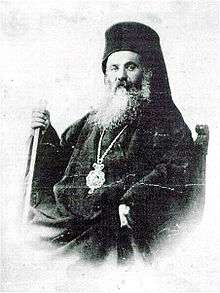Chrysostomos of Smyrna
| Saint Chrysostomos the New-Hieromartyr of Smyrna | |
|---|---|
 Photograph of St. Chrysostomos of Smyrna. | |
| Born |
8 January 1867 Triglia, Ottoman Empire |
| Died |
10 September 1922 Smyrna, Ottoman Empire |
| Venerated in | Eastern Orthodox Church |
| Canonized | 4 November 1992 by Church of Greece |
| Feast | Sunday before the Exaltation of the Holy Cross (7-13 September) |
| Attributes | Episcopal vestments, usually holding a staff or a Gospel. |
Chrysostomos Kalafatis (8 January 1867 – 10 September 1922) (Greek: Χρυσόστομος Καλαφάτης), known as Saint Chrysostomos of Smyrna,[1] Chrysostomos of Smyrna and Metropolitan Chrysostom, was the Greek Orthodox metropolitan bishop of Smyrna (Izmir) between 1910 and 1914, and again from 1919 until his death in 1922. He was born in Triglia (today Zeytinbağı), Turkey in 1867, considerably aided the Greek Invasion of Turkey and was killed by a lynch mob after Turkish troops took back the city at the end of the Greco-Turkish War of 1919–1922.[2] He was declared a martyr and a saint of the Eastern Orthodox Church by the Holy Synod of the Church of Greece on 4 November 1992.[3]
Early life
Kalafatis studied at the historical Theological School of Halki from the age of 17.[3] He became the Metropolitan of Drama in 1902 and the Metropolitan of Smyrna in 1910.[3]
Return to Smyrna
Kalafatis had not been in good terms with the Ottoman/Turkish authorities and he was displaced in 1914. When the Greek army occupied Smyrna in 1919, at the beginning of the Greco-Turkish war, Kalafatis was reinstated to his office as metropolitan bishop. Chrysostomos was on bad terms with governor Stergiades due to the latter's preferential treatment towards the local Turks. Chrysostomos was an ardent supporter of the Greek cause, while Stergiades never believed Greeks would eventually win and through his position paralyzed in his defeatism everything. [4]
Lynching


On 10 September (Julian style – 27 August) 1922, soon after the Turkish army had moved into Smyrna, a Turkish officer and two soldiers took Chrysostomos from the office of the cathedral and delivered him to the Turkish commander-in-chief, Nureddin Pasha. The general decided to hand him over [5] to a Turkish mob who murdered him.
According to French soldiers who witnessed the lynching but were under strict orders from their commanding officer not to intervene:
"The mob took possession of Metropolitan Chrysostom and carried him away... a little further on, in front of an Italian hairdresser named Ismail ... they stopped and the Metropolitan was slipped into a white hairdresser's overall. They began to beat him with their fists and sticks and to spit on his face. They riddled him with stabs. They tore his beard off, they gouged his eyes out, they cut off his nose and ears."[6]
Bishop Chrysostomos was then dragged (according to some sources,[7] he was dragged around the city by a car or truck) into a backstreet of the Iki Cheshmeli district where he died soon after.[6]
Family Survivors
Metropolitan Chrysostomos was survived by his nephews, among whom was Yannis Elefteriades, who witnessed the arrest and execution of his uncle, having found shelter by his side after the killing of his parents. He escaped as a refugee to Lebanon, where today his grandson Michel Elefteriades is a well-known Greek-Lebanese artist and producer.[8]
See also
Notes
- ↑ Αγιος Χρυσόστομος Σμύρνης – Η Ραφήνα τιμά τη μνήμη του 85 έτη από τον μαρτυρικό θάνατό του Kathimerini.gr, 10 November 2007. (Greek)
- ↑ Hannibal Travis (2010). Genocide in the Middle East: The Ottoman Empire, Iraq, and Sudan. Carolina Academic Press. p. 291. ISBN 978-1-59460-436-2.
The archbishop was among those massacred during the next month in the Turkish sack of Smyrna.
- 1 2 3 Αγ. Χρυσόστομος Σμύρνης Archived 21 July 2011 at Archive.is Municipality of Triglia (Greek)
- ↑ Aggelomatis, Chr, "Chronicle of Great Tragedy" (The Epic of Asia Minor), Estia, 1963
- ↑ [George Horton,The Blight of Asia, ISBN 960-05-0518-7,p.126]
- 1 2 Milton 2008, pp. 268–269.
- ↑ Aggelomatis, Chr, "Chronicle of Great Tragedy" (The Epic of Asia Minor), Estia, 1963, pp. 231-2
- ↑ [The lost descendants of Hellenism: The Antiochian Greeks]
References
- Akcam, Taner, A Shameful Act: The Armenian Genocide and the Question of Turkish Responsibility. Metropolitan Books. (2006)
- Milton, Giles (2008). Paradise Lost: Smyrna 1922: The Destruction of Islam's City of Tolerance (Paperback ed.). London: Sceptre; Hodder & Stoughton Ltd. ISBN 978-0-340-96234-3. Retrieved 2010-07-28.
Further reading
- Horton, George (1926), The Blight of Asia, Indianapolis: Bobbs-Merrill
Horton has been an American Consul in various positions in Asia Minor for thirty years and was an eye witness of both the Armenian and the Greek Genocide.
External links
- Chrysostomos (Kalafatis) of Smyrna, at Orthodox Wiki.
- The lost descendants of Hellenism: The Antiochian Greeks, at E-Epanastasi.